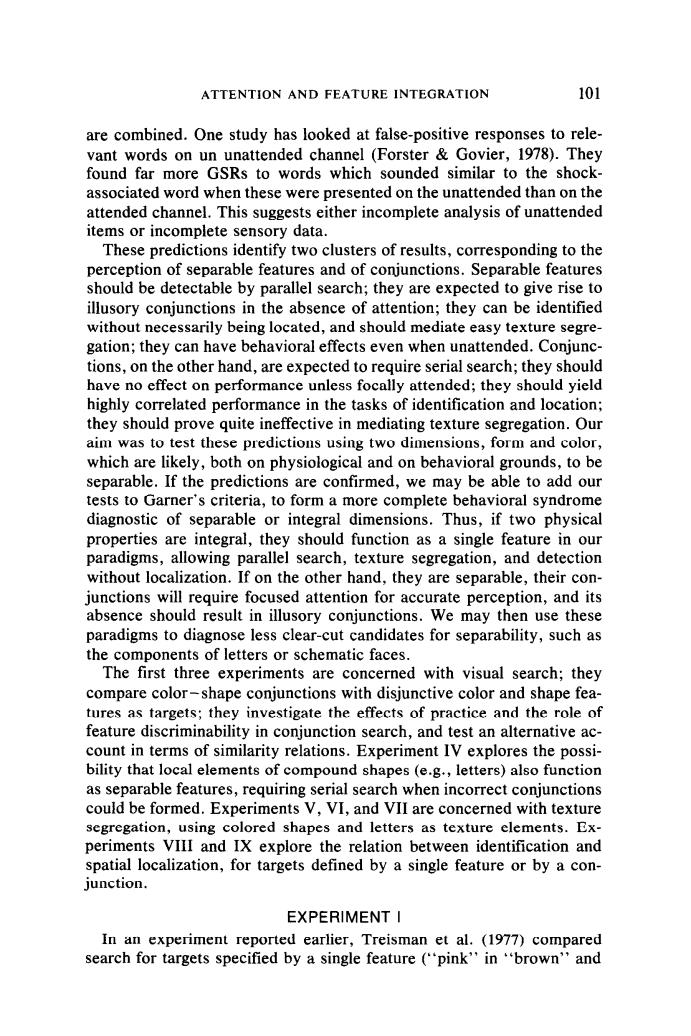正在加载图片...

ATTENTION AND FEATURE INTEGRATION 101 are combined.One study has looked at false-positive responses to rele- rds on u mor unattended channel (,1.They GSRs to words which sound ed similar to tha sho associated word when these were presented on the unattended than on the attended channel.This suggests either incomplete analysis of unattended items or incomplete sensory data. These predictions identify two clusters of results.corresponding to the rable fea and of onjunctions. able by parallel search;they are expected illusory conjunctions in the absence of attention;they can be identified without necessarily being located.and should mediate easy texture segre. gation;they can have behavioral effects even when unattended.Conjunc- tions,on the other hand,are expected to require serial search;they should perf ormance u nless ney sho ld vield highly correlated performance in the tasks of identification and location; they should prove quite ineffective in mediating texture segregation.Our aim was to test these predictions using two dimensions,form and color. whichare likely,both on physiological and on behavioral groundstobe separable.If the predi tions are confirmed a e to add sts to er s cnt ia,to form a more complete oral y1 diagnostic of separable or integral dimensions.Thus,if two physica properties are integral,they should function as a single feature in our paradigms,allowing parallel search,texture segregation,and detection without localization.If on the other hand,they are separable,their con- will r sed atter accur te perc eption e should result n illu sory conjune tions e may th paradigms to diagnose less clear-cut candidates for separability,such as the components of letters or schematic faces. The first three experiments are concerned with visual search:they compare color-shape onjunctions with disjunctive color and shape fea argets ey investigat effe of practice e and the role of feature discriminability in conjunction search,and test an alternative ac count in terms of similarity relations.Experiment IV explores the possi- bility that local elements of compound shapes (e.g.,letters)also function as separable features,requiring serial search when incorrect conjunctions could be formed.Exp tsV VI and VII ar concerned with tex ored shapes an etters as text el me periments VIII and IX explore the relation between identification and spatial localization,for targets defined by a single feature or by a con- lunction. EXPERIMENT I In an experiment reported earlier,Treisman et al.(1977)compared search for rget specified by a single feature ("pink" 0 and ATTENTION AND FEATURE INTEGRATION 101 are combined. One study has looked at false-positive responses to relevant words on un unattended channel (Forster & Govier, 1978). They found far more GSRs to words which sounded similar to the shockassociated word when these were presented on the unattended than on the attended channel. This suggests either incomplete analysis of unattended items or incomplete sensory data. These predictions identify two clusters of results, corresponding to the perception of separable features and of conjunctions. Separable features should be detectable by parallel search; they are expected to give rise to illusory conjunctions in the absence of attention; they can be identified without necessarily being located, and should mediate easy texture segregation; they can have behavioral effects even when unattended. Conjunctions, on the other hand, are expected to require serial search; they should have no effect on performance unless focally attended; they should yield highly correlated performance in the tasks of identification and location; they should prove quite ineffective in mediating texture segregation. Our aim was to test these predictions using two dimensions, form and color, which are likely, both on physiological and on behavioral grounds, to be separable. If the predictions are confirmed, we may be able to add our tests to Garner’s criteria, to form a more complete behavioral syndrome diagnostic of separable or integral dimensions. Thus, if two physical properties are integral, they should function as a single feature in our paradigms, allowing parallel search, texture segregation, and detection without localization. If on the other hand, they are separable, their conjunctions will require focused attention for accurate perception, and its absence should result in illusory conjunctions. We may then use these paradigms to diagnose less clear-cut candidates for separability, such as the components of letters or schematic faces. The first three experiments are concerned with visual search; they compare color-shape conjunctions with disjunctive color and shape features as targets; they investigate the effects of practice and the role of feature discriminability in conjunction search, and test an alternative account in terms of similarity relations. Experiment IV explores the possibility that local elements of compound shapes (e.g., letters) also function as separable features, requiring serial search when incorrect conjunctions could be formed. Experiments V, VI, and VII are concerned with texture segregation, using colored shapes and letters as texture elements. Experiments VIII and IX explore the relation between identification and spatial localization, for targets defined by a single feature or by a conjunction. EXPERIMENT I In an experiment reported earlier, Treisman et al. (1977) compared search for targets specified by a single feature (“pink” in “brown” and